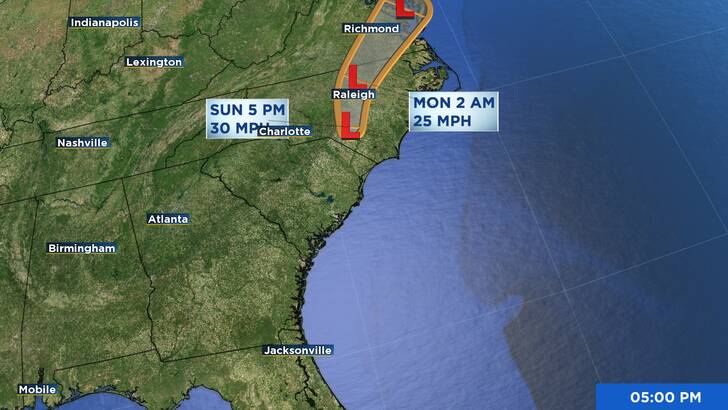Location |
65 miles SSW of Raleigh North Carolina |
Wind |
30 mph |
Heading |
NNE at 10 mph |
Pressure |
29.74 |
Coordinates |
79.0W, 34.9N |
Suggested Videos
The center of Tropical Depression Chantal was situated close to latitude 34.9 North, longitude 79.0 West, at 500 PM EDT (2100 UTC). The depression is traveling at a speed of about 10 mph (17 km/h) toward the north-northeast. Over the course of the following day, Chantal is predicted to veer more northeast, which will accelerate its onward motion.
With greater gusts, the maximum sustained winds are close to 30 mph (45 km/h). As it proceeds further inland, it is predicted to weaken over night, and as it approaches the Virginia Capes on Monday, it may somewhat strengthen again.
A minimum central pressure of 1007 mb (29.74 inches) is estimated.
* Central North Carolina * South-central Virginia are under flood watches.
The Tropical Cyclone Discussion’s AWIPS header MIATCDAT3 and WMO header WTNT43 KNHC provide the key messages for Tropical Depression Chantal.
Tropical Depression Rainfall Parts of central North Carolina and south-central Virginia will continue to see significant rainfall through Monday because to Chantal. Rainfall is predicted to range from 2 to 4 inches overall, with local totals as high as 6 inches. There will still be a high chance of flash floods.
The National Weather Service Storm Total Rainfall Graphic, accessible at hurricanes.gov/graphics_at3.shtml?rainqpf, provides a comprehensive representation of the predicted rainfall and flash flooding linked to Tropical Depression Chantal.
See the companion storm summary at WBCSCCNS4 with the WMO header ACUS44 KWBC or click this link to view a list of rainfall observations (and wind reports) related to this storm: www.wpc.ncep.noaa.gov/discussions/nfdscc4.html
TORNADOES: Over portions of eastern North Carolina, there is a chance of one or two isolated tornadoes today.
SURF: Over the course of the next day or so, beaches along the U.S. East coast, from northeastern Florida to the Mid-Atlantic states, are predicted to continue to experience life-threatening surf and rip current conditions.
Here is a graphic representation of the risk of rip currents in the United States: hurricanes.gov/graphics_at3.shtml?ripCurrents




